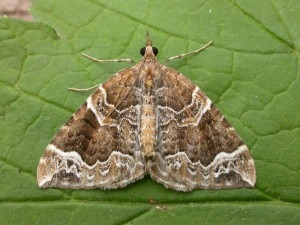7 moth-ers met up for this meeting at the SWT reserve at North Cove, Barnby, a site that has been trapped a few times before by the group. The site has areas of carr woodland, wet meadows with many wildflowers and reed edged ditches.
Targets for the night were Dentated pug (as there is a lot of Yellow loosestrife present on the site) and White-mantled wainscot (not recorded at this site before). It promised to be a good night with warm temperatures and cloud cover.
8 traps were deployed, 2 along a track beside a reed lined ditch with the rest around the woods and wet meadows. Good numbers of moths soon started coming in with the first interesting species appearing early on – a Double kidney, a new site for this scarce north Suffolk moth.
A check of the traps showed it was going to be a great night with large quantities of moths in and around them. The first target moth, the White-mantled wainscot was found by one of the traps beside the ditch, exactly where expected. The traps in the wet meadow held the other target, Dentated pug, the first Suffolk record for a number of years. But it actually got even better, as a Small dotted footman was found in the grass beside the other trap, only the 2nd Suffolk record! This is a very interesting sighting as this is close to the Norfolk broads, the usual haunt of the moth so it could be breeding in the area. Future searching may provide more evidence of this. The only other record was a migrant one at Bawdsey.
Other macro highlights included: Double lobed, Lilac beauty, Dotted fan-foot, Phoenix, Gothic, Blackneck, Lesser cream wave, Clouded magpie (and Magpie), Slender pug, Small scallop, Reed dagger and Silky wainscot.
Micros of interest were: Anania perlucidalis, Bucculatrix cidarella, Platytes alpinella, Donacaula forficella, Evergestis pallidata, Orthotelia sparganella, Ostrinia nubilalis, Endothenia quadrimaculana, Athrips mouffetella, Stathmopoda pedella, Thiotricha subocellea, Ancylis badiana, Donacaula mucronellus, Gelechia sororculella, Oidaematophorus lithodactyla, Argyresthia pygmaeella, Epinotia tenerana, Anania crocealis, Agonopterix conterminella and Cochylidia rupicola. There was also a very interesting plume that is still under discussion over it’s id. Looking like isodactylus at present, more news will be posted once known.
This was one of those ‘classic’ warm summer nights that as moth-ers you always hope for but often don’t happen in Britain. Huge numbers of moths seen by the end of the night, with a species total of over 230 species. Real quality too including the major surprise.
The great moth year continues!!
Neil
Stop press: The mystery plume moth has now been confirmed by Colin Hart as Hoary plume Platyptilia isodactylus, confirming my initial id. First Suffolk record for a very long time.






It was a terrific night Neil! My best ever with the Suffolk Moth Group!
Muslin Footman was also another good one to find.
I only have records for the site for 2016 and now 2017, but at least 161 new species were added to this list as a result of last Friday’s visit. This has more than doubled the species count to 300 for the 2 years of records that I have.
The warden and reserve staff were delighted to hear about the results from Friday and that the reserve hosts so many rare and important species.